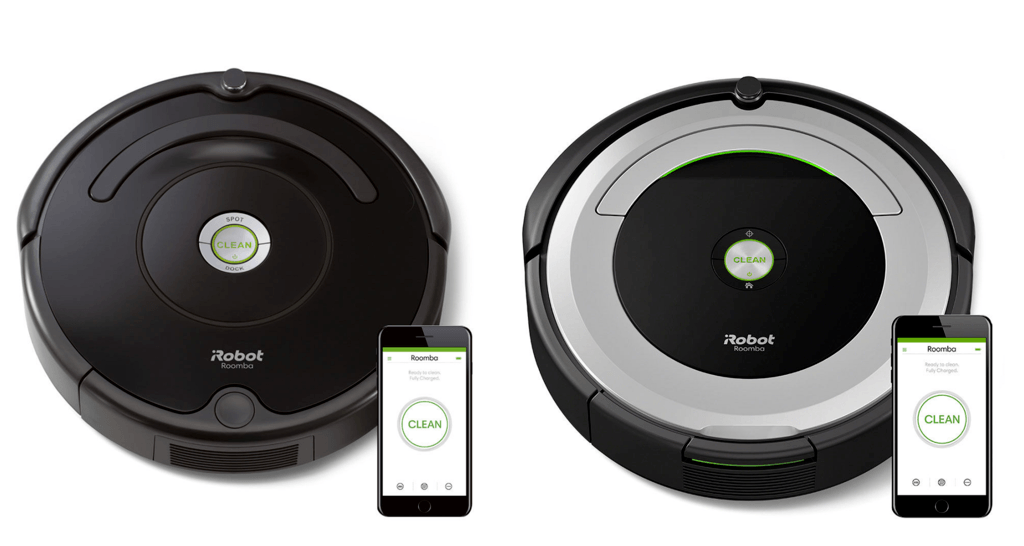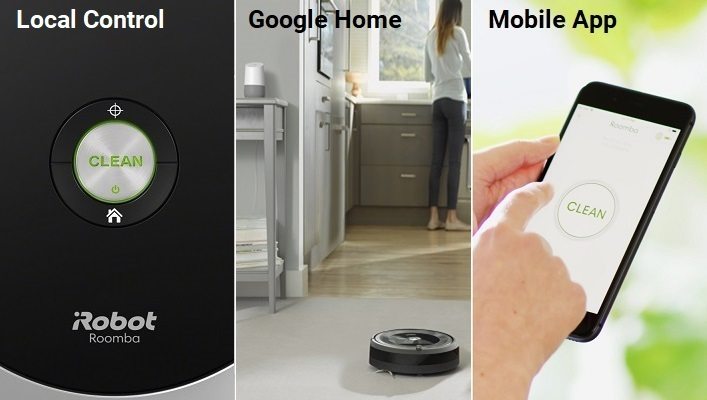When it comes to budget-friendly robot vacuums, most people believe they need to search for an off-brand or an unknown manufacturer to get a good deal. However, iRobot has amazing robots for great prices if you know where to look. The Roomba 675 and Roomba 690 are two such models.
In this article, we will look at the two robots and explain their differences and similarities. The goal is to provide you with the needed information to help you decide which model is best for you. For my money, the best option is the Roomba 675.
Contents
Differences between Roomba 675 and Roomba 690
There are only four differences between the two models. Let’s take a look at what they are.
- The Roomba 690 comes with one virtual wall barrier; the Roomba 675 doesn’t come with any.
- In the packaging you will find an extra filter with the 690; there aren’t any extras with the 675.
- The price, under normal circumstances, is higher for the 690 than then 675.
- There are two color schemes: the 690 is all black while the 675 is black and silver.
Similarities between the Two
Everything not listed above is going to be the same for the two machines. Here is a rundown of the most prominent features they share in common.
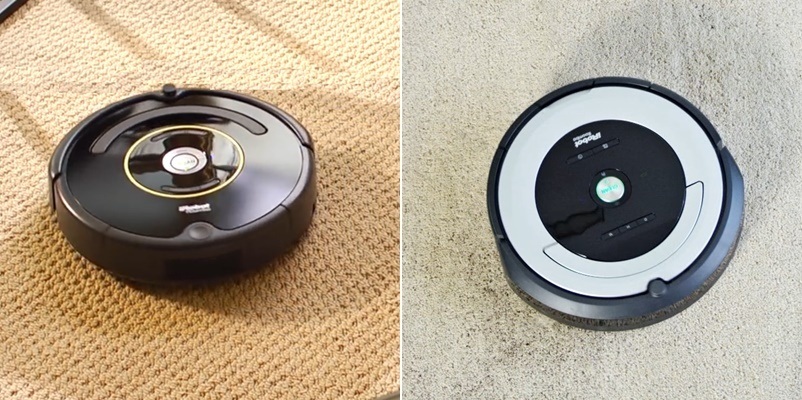
- Both robots use the AeroVac filtration system, which utilizes a HEPA quality filter.
- Each device has wireless communications for controls with the mobile app or voice commands.
- Each robot uses onboard sensors and a pseudo-random navigation pattern to clean your home.
- The Roomba 675 and 690 are both rated for all floor types using a soft bristle brush roll to collect dirt, dust and debris.
- The battery found in each unit is a 1800mAh pack with a runtime of up to 90 minutes.
- Both models will return to the charging dock on their own when the battery gets low.
- Neither robot will automatically resume a cleaning cycle after a battery charge.
Specifications Chart
To see the two models side-by-side, take a look at this chart. It will outline everything the robots do and do not offer.
| Roomba 675 | Roomba 690 | |
| Size | 13.3×13.3×3.6 inches | 13.3×13.3×3.6 inches |
| Weight | 7.8 pounds | 7.8 pounds |
| Navigation | IAdapt 1.0 | iAdapt 1.0 |
| Color | Silver on Black | Black on Black |
| Battery | 1800mAh lithium-ion | 1800mAh lithium-ion |
| Runtime | Up to 90 minutes | Up to 90 minutes |
| Charge Time | 3 hours | 3 hours |
| Automatic Recharge | Yes | Yes |
| Entire Level Clean | No | No |
| Filter | AeroVac | AeroVac (1 extra included) |
| Drop Sensors | Yes | Yes |
| Bump Sensors | Yes | Yes |
| Dirt Detection Sensors | Yes | Yes |
| Camera Navigation | No | No |
| Wireless Communications | Yes | Yes |
| Mobile App | Yes | Yes |
| Voice Controls | Yes | Yes |
| Floor Types | All | All |
| Collection Bin Capacity | 0.5L | 0.5L |
| Side Brushes | 1 Side Brush | 1 Side Brush |
| Containment | None included | 1 Dual Mode Virtual Wall Barrier |
| Warranty | 1 year | 1 year |
| Price | Check on Amazon | Check on Amazon |
Comparing the Roomba 675 and 690 in Detail
Now we will take a look at the important features and options of the two robots and help you decide which is the better option for your specific needs.
The Batteries are Small But are Efficient
Both the Roomba 675 and the Roomba 690 utilize the 1800mAh battery pack. The average life expectancy is about three years or 5000 recharging cycles. Daily, though you can expect the batteries to give you about an hour and a half of runtime.
What this means for you is that you can expect to have an entire floor cleaning in a single charge if your floor plan is between 900 and 1200 square feet. If it is larger, it may take a couple of cycles to cover it all.
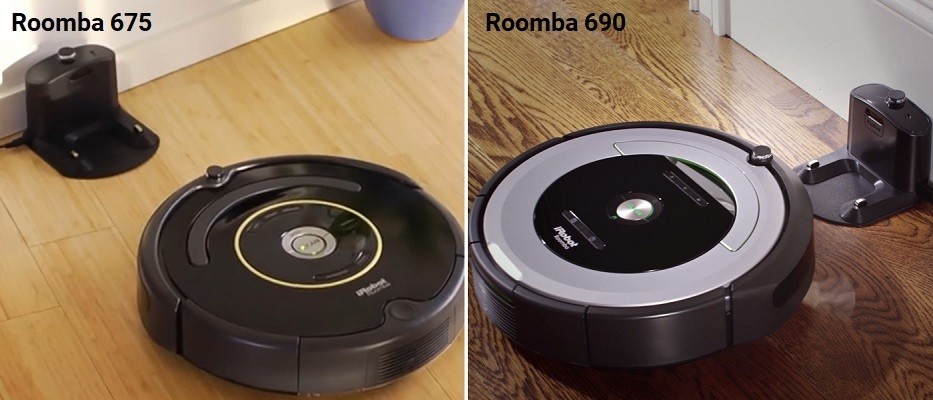
When the two robots detect that their battery has fallen below 15 percent, they will pause the cleaning cycle and find their way back to the charging dock. It will take about three hours to charge the battery fully. At this time you can either wait until the next scheduled cleaning time or manually restart the cleaning cycle.
You should note that there isn’t a mapping feature with these two models. Each cleaning cycle will be like starting all over. However, because of the pseudo-random cleaning patterns used, no two cycles will be the same and your entire floors will be covered over successive runs.
Bottom Line: This is a tie. Both systems use the same battery and have the same runtime expectancy.
The Filtration Remains Some of the Best in the Industry for Both the 675 and the 690
When the 600 series were originally released, the filtration and suction technology was named AeroVac. This is still the technology found in them today. However, it has been superseded by the AeroForce technology. The main difference between the two is the type of filters used and the amount of suction created.
With the AeroVac system, though, every filter is HEPA rated and will capture up to 99 percent of all in-home allergens. This includes pet dander, mold and mildew spores, pollen and dust mites. The reduction in these allergens can drastically cut down on the number of allergic reactions in your home.
The main difference between the two models here is that the 690 comes with a filter installed and a second filter in the box. Because you will be changing these filters out every four to six months, having the extra filter included in the purchase can be a big help to get you started.
However, you will need to purchase more in the future anyway and when you do, they come in packs of three. Any cost savings up front is pretty much negated since you will need to order more in the first year with whichever model you choose.
Bottom line: The Roomba 690 wins. Having an extra filter to start is better than not, though, in the end, it makes very little difference.
The Control Options are Quite Robust Despite the Price of the Robots
Most entry-level or budget-friendly robots on the market won’t have many control options and very few will actually have multiple methods. The Roomba 675 and 690 both come with a few control options to best suit your needs.
The first is the local controls. By utilizing the three buttons on the robot face itself, you can start, stop pause or resume a cleaning cycle. There is also a button to return the robot to the charging dock if you are done with it for the time being, or otherwise, just need to stop the cleaning cycle.
You can also have either the 675 or the 690 perform a spot cleaning by pressing the other button. This will cause the robot to spiral in a 3-foot radius concentrating on the specific area you set it down on.
You Also Have the Option of Using Your Voice
Since both models come with wireless communications, they can connect to your home network. With this done you can then use an Amazon Alexa, or Google Assistant enabled device to control the robots.
You can tell Alexa or Google to have the robots start, stop, pause or resume a cleaning cycle. There are also options to have the robot perform a spot clean or return to the charging dock.
While there are more advanced options for some of the newer robots, the basics are covered with the Roomba 675 and the Roomba 690. Now you can have full control over the cleaning with just your voice.
The Most Used Option is the Mobile App
By far, the most used (and most useful) option is control through the iRobot Home app. Not only will you be able to utilize all of the features from the local and voice controls, but you will also be able to create and edit schedules, see the status of the robot and battery as well as the ability to do all of this from anywhere.
You don’t need to be home to use the app and have it pass along the information to the robot. If, for example, you have company coming over later that evening, you can schedule a cleaning while you are at the office and come home to clean floors in time for your guests to arrive.
Bottom Line: This round is a tie. Both models use the same control features as one another.
Containment Choices are the Same with Both Models, but the 690 has a Leg Up
Aside from the color and, under normal situations, the price, containment is the only other difference between the two models.
Both the Roomba 675 and the Roomba 690 are compatible with the virtual containment options produced by iRobot. This includes the latest version known as the Dual Mode Virtual Wall Barriers. The difference is that the Roomba 690 comes with one tower and the 675 doesn’t come with any.
These towers use infrared beams to prevent the robots from crossing into areas you don’t want them to have access to. For example, linear mode produces a beam in a straight line that goes out up to 10 feet. This is useful for blocking off entrances or exits to rooms, or to partition off certain areas of the room.
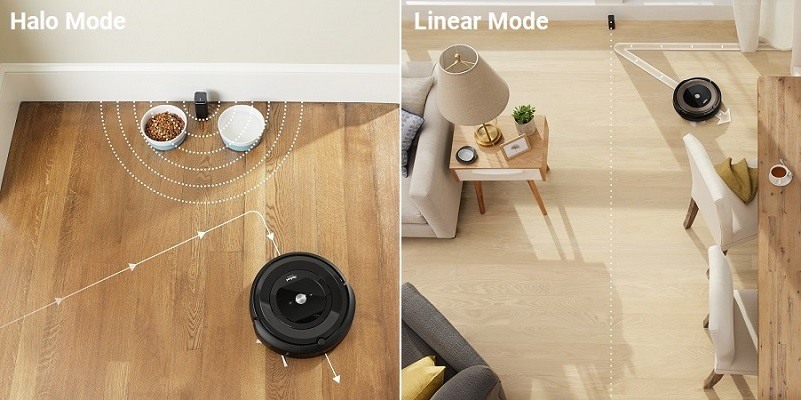
In halo mode, though, the beam is pushed out in a circle up to four feet in diameter. This is useful for preventing the robot from getting near pet food dishes, floor lamps, or wobbly end tables.
Because the 675 doesn’t come with a barrier, you will have to purchase them separately. They come in packs of two from the iRobot store and will generally run you about $80. You may find that the single barrier that is included with the 690 isn’t enough and will have to purchase another set anyway.
Bottom Line: The Roomba 690 wins. Having a single barrier included is better than not having any.
Frequently Asked Questions
Let’s cover a few of the most common questions regarding the Roomba 675 and 690 models.
Q. Does the 600 series use the brushless rollers like the 900 series?
A. No. The brushless, tangle-free extractors are a late stage introduction to the 800 series and the 900 series robots. Before these, including the 675 and 690, the robots used a bristle brush roller commonly found on most upright vacuum models.
[easyazon_image align=”center” height=”500″ identifier=”B07DL4QY5V” locale=”US” src=”https://smartrobotichome.com/wp-content/uploads/2019/05/51FzP2B6jGDL.jpg” tag=”srh-easyazon-20″ width=”500″]The bristles are a mixture of soft and firm bristles that will clean any floor type. However, they do have the same issues as most other machines where they pick up strings, long hair and carpet fibers that become entangled on the rollers. You will have to keep a regular maintenance schedule to keep the rollers clear of tangles and debris.
Q. What is the recommended maintenance schedule for these two robots?
A. There are certain things you will need to check and replace regularly with the Roomba 675 and 690 models. First is the collection bin. While they do have a moderate size (0.5L) capacity, it is recommended that you empty them on a daily basis or at least after every cleaning cycle. This should be done for the first few weeks until the amount of collected debris begins to lessen.
You also need to check the brush roll and side brush every week. Clearing them of any tangles or debris and replacing them as they begin to wear down. The brush rolls should last you at least a year while the side brush usually lasts between six and nine months.
Other than that a weekly wipe down of the machine to keep the sensors clean or dust and the wheels cleaned of any debris will go a long way to keeping the robots performing at top levels.
Q. Is it easy to order parts?
A. It is quite simple to order parts. You will need the model number of your particular machine to ensure you are getting the right parts though. You also have a few options. You can order directly from the iRobot store and get fully compatible parts for either machine.
You can also browse Amazon, which is a trusted vendor, for genuine parts. You should be careful when going third party though and make sure your Amazon purchase is either fulfilled by Amazon or iRobot.
What I Like About the Roomba 675
- Large capacity collection bin.
- Powerful and efficient battery resulting in up to 90 minutes of runtime.
- HEPA quality filters for reducing in-home allergens.
What I Like About the Roomba 690
- Everything from the 675 list above, plus:
- The inclusion of a virtual wall barrier.
- Additional HEPA quality filter included.
In Conclusion
There is very little difference between the Roomba 675 and the Roomba 690. So how do you know which is the best option for you? Both models will have HEPA quality filtration and the ability to clean all floor types. Though you should be warned that high pile and shag carpeting can cause some issues with the brush rolls.
The collection bins are fairly large and the batteries are quite efficient, but the differences are what makes the choice easy for you. If you only need a single virtual wall barrier or want to save money in the short term with the extra filter included, then the Roomba 690 is the way to go.
However, because you will eventually need to purchase more filters and the barriers come in a pack of two when you buy them separately, the Roomba 675 is the better option in overall cost-effectiveness. Unless the Roomba 690 goes on sale, the less expensive 675 is the best bet to meet all of your needs.
